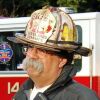Ever play the game called hot potato?
For those of you who haven’t, it’s an old school party game that’s fun, simple and gets everyone participating. Essentially, players form in a circle and pass around a steaming hot potato. These days, it’s typically a ball or similar toy, but in the old days when liability wasn’t so much a concern, an actual hot potato was used. (Hey, they were having fun, minor burns or not.)
With music playing, the participants keep passing the “potato” as fast as possible to not get “burned.” When the music stops, whoever is holding the potato (ball, whatever) is out! Start the music again and resume the same passing play with the remaining players until the music stops, again and again until there’s one player left. The last person left holding the potato is the winner.
In the fire service, we have a similar game. It’s when someone dials 911 because their world is on fire, the dispatcher activates the local volunteer fire department (rural, suburban or urban) and then waits … and waits … and waits. Again, there is a house on fire, the dispatcher has received multiple calls, and that one volunteer department’s tones go off again … and again. Or maybe the whistle blows until it burns out or whatever system of “HEY, COME DO THE JOB YOU CLAIM YOU DO” alerting exits – and yet no one responds. Or maybe a few show up, but no driver. Or maybe it’s senior firefighters who should no longer be interior firefighters. Or maybe a chief drives, meaning they can’t do their chief duties at the scene.
You know exactly what I am talking about.
What is needed when a house is on fire? Put another way, what do YOU want when YOUR house is on fire?
Response models and bad numbers
Let’s stay focused on our worst-case scenario here – a house fire, people trapped, and the local VFD fails to get out in a timely manner. What is “timely” exactly? Pretend your family is in that house. How “timely” would you like the fire department to arrive? There ya have it.
According to the NPFA 1720, this is what response times and staffing should minimally look like for VFDs:
- Urban Zones with >1,000 people/sq. mi. call for 15 staff to assemble an attack in 9 minutes, 90% of the time.
- Suburban Zones with 500-1,000 people/sq. mi. call for 10 staff to assemble an attack in 10 minutes, 80% of the time.
- Rural Zones with <500 people/sq. mi. call for 6 staff to assemble an attack in 14 minutes, 80% of the time.
- Remote Zones with a travel distance = 8 mi. call for 4 staff, once on scene, to assemble an attack in 2 minutes, 90% of the time.
Those are some very liberal numbers. Actually, those numbers suck if your house is on fire.
In some areas, you just have to accept this. You can make a difference, though. If you live in a rural or remote area, sprinkler your house and join the local VFD. However, if you live in a suburban or urban area, you are probably paying taxes (fire district, municipal tax or using tax dollars to fund a fire company, etc.), and you are probably under the impression that, when summoned, we will be there quickly. It’s a fair assumption.
Let’s compare the above NFPA 1720 standards (for volunteer departments) to NFPA 1710 (for paid departments), which calls for four qualified firefighters to arrive within 5 minutes, 90% of the time, as well as 15 qualified firefighters to arrive as part of the “Full Alarm Assignment” within 9 minutes, 90% of the time. (And please don’t start with the “NFPA is BS” BS. Those standards were – and still are – developed by firefighters, fire officers and chiefs with years of experience.)
I remember back in the 90s when NFPA 1710 and 1720 were being discussed and debated, plus the fighting that ensued because those representing the volunteers didn’t want to be held to the same requirements as career departments. Why?
Because they were volunteers. “You can’t expect volunteer fire departments to meet the same standards,” they would say. I don’t recall much discussion about what was best for the people having the fire.
One of the problems was that many who opposed being held to one standard refused to consider changing the volunteer model. In those discussions – and fierce arguments – opponents advocated the traditional “home or work response” model where fire sirens were sounded, home alert radios and beepers beeped, and whoever was available came running or driving really fast. It worked pretty well in the 40s, 50s, 60s and even some into the 70s, but even as communities were growing, the model stayed the same. Of course today, that model continues in many areas, and along with it the very real issues of recruitment, retention and often slow or non-existent turnout.
3 simple (initial) steps
A fully sprinklered dwelling would solve a whole lot of problems, but with homebuilders dating local politicians and other conflicts of interest at work, there are few communities where sprinkler mandates will ever occur. So for now, let’s consider three simple steps that can ease the problem.
- Ensure your volunteer fire department can get out with the number of needed firefighters. That means your leadership knows who is around and will turn out. That requires sign-up time as well as an app that your members update when responding – and responding means they’ll be at the firehouse in 2-3 minutes at most. Keep in mind that if you are in an area with firehouses from numerous jurisdictions very close to one another, the in-house staffing can be shared.
- Establish automatic mutual aid. If you know that your VFD is failing its responsibility, then set up automatic mutual aid. To be clear, this is mutual aid, not mooch-ual aid where one department continually bails out another.
- Set a time limit for second alarms. Resetting your tones again and again is BS. Either the members turn out for a dwelling fire or they don’t. And with an app, your dispatchers will know immediately who is responding. If they don’t instantly see over a dozen members turning out, then give them the authorization to strike the second alarm immediately. From transmitting the first alarm and immediately determining (through the app) that the turnout sucks to transmitting the second alarm should take about 30 seconds.
Band-Aid solutions and real solutions
It is UNFAIR, IRRESPONSIBLE AND IMMORAL of fire department leadership (chiefs, commissioners, mayors – whoever) to expect the fire dispatchers to be answering the call, alerting a fire department with an “unknown” response and answering 9-1-1 call after 9-1-1 call from citizens asking, “Where is the fire department?!” In 2022 the technology is there to immediately know who is turning out.
That’s the “hot potato” – the house is on fire, people are reported trapped, and the dispatcher has an immediate solution to get them help, other than hitting the tones and blowing the whistle over and over. However, if a fire department follows the three above steps, they have a relatively workable, cost-free Band-Aid solution.
I say “Band-Aid” because that’s all it is. It immediately increases the caller’s chance of getting help quickly by allowing the dispatcher to do what they say: “We will get you help immediately” or “help is on the way” vs. “I will alert the fire department but your guess is as good as mine if they will turnout or not.”
In addition to the above, it must be realized that the home response model is no longer effective in 2022 in suburban and urban areas. That is because the average-sized room furnished with modern products is fully engulfed in fire in three minutes. The same room, furnished with items 50 years ago, took 30 minutes to do the same.
The solution is for the members of the VFD to change the response model to in-house duty crews on a rotation basis. Yes, it is different, but so are today’s fires, and we have an obligation to change if we are actually going to provide timely responses and be who we claim to be. Volunteer fire service and related community leadership needs to own this and take steps to represent the public’s needs. The goal: 15-20 qualified firefighters with qualified chiefs en route within a minute or so.
This won’t be easy for some VFDs, but know that many have already changed to the in-house duty crew model – and it works. It also increases training, morale and pride within the membership of many departments.
What we like vs. what is needed
When we make our decisions based upon what we like, what’s best for us, and our reluctance to change vs. doing what’s best for those dialing 911, the people who are funding the service, guess who loses? And if that’s not an issue for you and your department, then things are even worse.
In hot potato, when the music stops, whoever is holding the ball is out, BUT the last person in the circle holding the potato ends up the winner. In our game – reality! – a dispatcher having to hold the hot potato means the person who dials 911 is the loser. Actually, there are two groups who end up holding the burning hot potato – the dispatchers and the citizen who is watching their world burn up. In reality, the citizen doesn’t even know there is a hot potato, but they are still unwitting participants in this dangerous game that some fire departments knowingly play.
So what’s the next step if you are still unable to recruit volunteers? Then it is time to educate your public about what your VFD can and cannot do, and start getting serious about mergers and consolidations as well as developing a plan for a career, paid service (which will not be simple). Those are the options … unless you have a better idea. I always welcome your thoughts.
This article, originally published in November 2022, has been updated.














